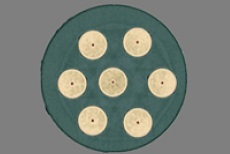Jun 1 2015
The Optoelectronics Research Centre (ORC) at the University of Southampton, is making its next-generation fibre available for purchase (Stand B2 124, Laser Munich, Germany, June 22-25).
 MEF-passive 7 element optical fibre
MEF-passive 7 element optical fibre
At the Laser exhibition in Munich (June 22-25), the ORC will be promoting its next-generation optical fibre, which until recently had not been openly available.
Fibres that are available for sampling and to purchase include rare-earth-doped fibres with ultra-high dopant concentrations; large mode area fibres; high bend radius fibres; multi-trench fibres; and novel compositions with extreme aluminium or germanium concentrations.
These fibres are the basis of the ORC’s prestigious publication record and Southampton has long been the research fibre partner of choice in European consortia. In addition to preparing to participate in Horizon 2020, the ORC is now granting the wider community access to this unique resource. The service will enable the evaluation of ORC fibres in products and research programmes at the earliest stages of development, helping to accelerate performance, adoption and commercialisation of optical fibre and photonics-based products.
“At the moment the only way to get fibre from the ORC is as part of a full commercial or academic collaboration,” said Professor Sir David Payne, Director of the ORC.
“We wanted to enable any organisation to get hold of small quantities of a fibre that the ORC has already made or can easily make. As the ORC can now routinely make fibre that far exceeds the capability of fibre commercially available, this service gives external organisations access to usable samples of those fibres quickly and easily. This will enable engineers to see for themselves how these fibres can enhance their system performance and enable new products.”
Next-generation fibres developed at the ORC have enabled a plethora of new applications in the last decade: from high-power lasers and laser delivery, to high bandwidth communications, and visible and infrared sensing.
As part of the new service, the ORC will hold a small range of research-grade fibres in stock for immediate delivery with the range continually adjusted over time to include cutting-edge fibres not commercially available. Fibres will be supplied for engineering development and research only. Once an application requires volume supply and the market demand is established, the ORC will work with commercial fibre manufacturers to transfer the fibre to production.
“If someone wants to get hold of a fibre that was used in a particular ORC research publication, they can now do this,” said Professor Jayanta Sahu, Head of Fibre Fabrication at the ORC.
“Engineers will now be able to demonstrate the impact of that next-generation fibre on their system performance and can develop experience of working with these new fibres in order to build a commercial case for custom next-generation fibre design. We anticipate supply of these fibres will facilitate further industrial collaborations to optimise fibres for an individual application.”
To request a contact about speciality optical fibres developed by the ORC, please visit www.zeplerinstitute.com/fibre